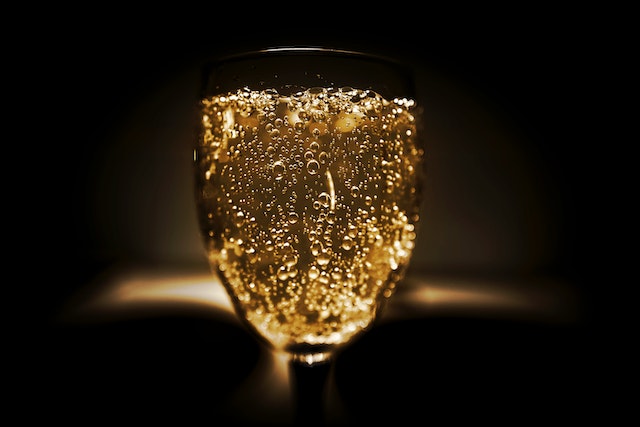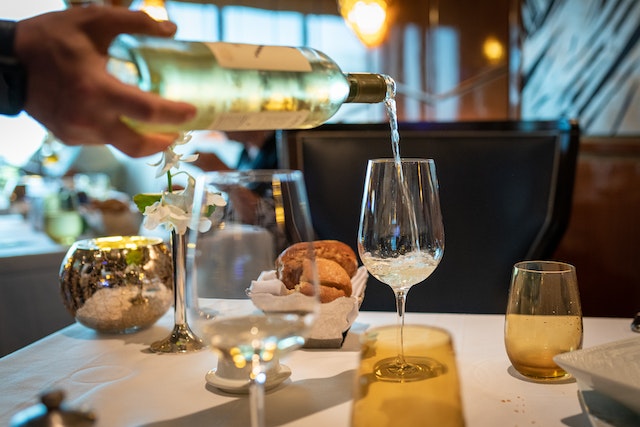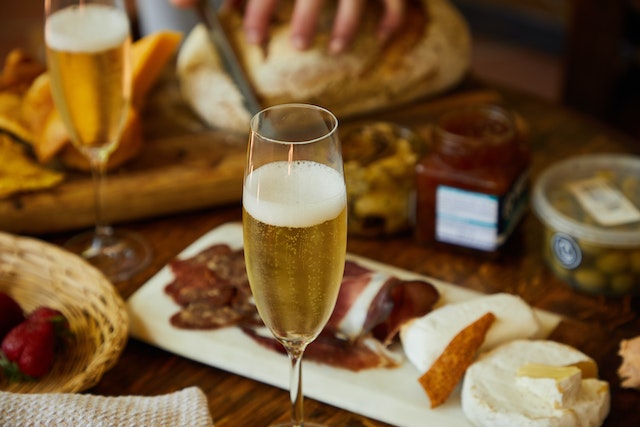If you’ve ever been to a wine tasting, you may have noticed that there’s a specific type of wine that’s served in champagne glasses and labeled as “champagne.” But what is the difference between sparkling wine and champagne? And why does it matter? In this blog post, we’ll explore the differences between sparkling wine vs champagne, and explain why they’re not exactly the same thing. So if you’re curious about what makes these two types of wines different, stay tuned! We’ll clear up any confusion once and for all.
Table of Contents
What Is Sparkling Wine?
Sparkling wine is essentially a bubbly or carbonated wine made from different varieties of grapes. It can be found in still and sparkling forms, both featuring a light body with a slightly sweet flavor. In the U.S., there are two types of sparkling wines - Champagne and Prosecco - each boasting their own distinct character, taste profile, and price point. Sparkling wines generally have higher acidity levels than still wines, making them an ideal accompaniment for many meals or for sipping on its own. When it comes to serving sparkling wine, it should be kept cold in order to retain its crispness and effervescence. The label on the bottle will often provide instructions as to how best serve the wine.
Sparkling wine can be enjoyed on its own, or it can also be incorporated into a variety of different cocktails to add an extra sparkle and flavor. Whether you’re celebrating a special occasion or just looking for something special to drink in the evening, sparkling wine is guaranteed to make your night a little brighter. From crisp cava to elegant champagne, there’s sure to be the perfect sparkling wine for any occasion. So why not pop open some bubbly and enjoy some delicious sparkling wines?
What Does Sparkling Wine Go Well With?

Sparkling wines are highly versatile and can be paired with a wide variety of foods. They go particularly well with appetizers, fruits, desserts, and salty snacks—allowing for a delicious combination of sweet and savory flavors. Sparkling wines can also serve as perfect accompaniments to meals such as seafood dishes, salads, pastas, and light entrees. For example, Italian sparkling wines pair especially well with pasta dishes like carbonara or risotto. Additionally, some people enjoy pairing certain sparkling wines with pizza or sushi.
The key is to consider the overall flavor profile of the wine against the dish being served. Consider matching sweetness levels between food and drink when making your selection; if one is too sweet compared to the other, it can throw off the flavor of both. Also take into account the acidity and tannin levels in the wine; they should be balanced with the flavors of the food being served. Finally, if you’re looking for a bit more complexity, try pairing sparkling wines with fruits or rich dessert dishes to bring out their fruity notes.
No matter what food you decide to pair your sparkling wine with, there’s sure to be an amazing combination that will tantalize your taste buds! With a little experimentation and creativity, you can find the perfect match between sparkling wine and delicious cuisine—just remember to keep an open mind when making your selection.
With its versatility and unique flavor profile, sparkling wine is the perfect accompaniment for any occasion. Don’t be afraid to experiment and find out what flavors work best together—you might just discover your new favorite combination!
What Is Champagne?
Champagne is an important part of any celebration. It is a sparkling wine made exclusively in the Champagne region of France and has been a symbol of luxury, sophistication and prestige for centuries. It is made from Pinot Noir, Chardonnay or Pinot Meunier grapes and blended with liqueurs to give it its signature effervescence. The regions clay-limestone soil helps create the unique flavor profile that makes champagne so special and sought after.
As champagne ages, its flavors are further developed which can range from floral to fruity, spicy to nutty. When served in the correct temperature and glassware, champagne can be a truly sensory experience unlike any other type of wine. Whether enjoyed at a special occasion or just a night in, champagne is an unforgettable way to celebrate.
It’s important to remember that there are strict regulations in place to ensure that only wines produced and bottled within the Champagne region of France can be called ‘Champagne’. Any sparkling wine made outside of this area cannot be referred to as such and will simply be labelled as a ‘sparkling wine’ or something similar. The French government also has some rules about how long champagne should age before it’s released on the market – from nine months for non-vintage up to fifteen years for vintage. This further contributes to its unique flavor characteristics. So next time you crack open a bottle of bubbly, take a moment to appreciate just how special it is and the dedication behind its production.
What Are Different Types Of Champagne?

Champagne is a bubbly, refreshing beverage that has been enjoyed by people around the world for centuries. There are several different types of Champagne available on the market today and each one can offer a unique flavor and experience. Here are some of the more popular styles:
Non-Vintage (NV) Champagnes – Non-vintage Champagnes are blends made from multiple vintages to create a consistent product. It’s typically less expensive than vintage Champagne but still offers many of the complexities of its vintage counterparts.
Vintage Champagnes – Vintage Champagnes are made from a single year’s harvest. This requires winemakers to pay closer attention to grape selection, harvest times and blending. As a result, vintage Champagnes tend to be more expensive than non-vintage varieties but can bring robust flavors and aromas that are associated with the year’s harvest.
Rose Champagnes – Rose Champagne is made by mixing still red wine and white sparkling wine together. It has a unique flavor profile that typically includes fruity, floral notes along with hints of strawberries or raspberries.
Demi-Sec Champagnes – Demi-Sec champagnes have higher sugar levels than other styles of sparkling wines resulting in a sweeter taste. They are usually served as an accompaniment to desserts such as fruit tarts or cakes because their sweetness helps to balance out the tartness of the dessert.
Blanc de Blancs Champagnes – Blanc de Blancs champagnes are made from 100% Chardonnay grapes and are known for their light, crisp flavor profile. This style of champagne is often served as an aperitif before a meal or enjoyed with lighter foods such as fish dishes.
Blanc de Noirs Champagnes – Blanc de Noirs champagnes are made exclusively from red grape varieties such as Pinot Noir and/or Pinot Meunier. These champagnes tend to have more body and complexity than other styles due to the dark-skinned grapes used in production. They can pair well with bolder flavors like grilled meats or cheeses.
Champagne is a versatile beverage that can be enjoyed in many different styles, from the light and crisp Blanc de Blancs to the full-bodied Blanc de Noirs. With so many options available it’s easy to find a Champagne style that suits your palate. So why not pop open a bottle and celebrate!
>>> See more: How to Open Sparkling Wine
Sparkling Wine Vs Champagne Comparison
When comparing Sparkling Wine and Champagne, the differences can be seen by looking at where the wines come from, the types of grape varietals used to make them, their taste profiles, and pricing.
Starting with regionality, Sparkling Wine is not limited to just one specific area or country while Champagne comes exclusively from France’s Champagne region. Because of this regional limitation, Champagne grapes are grown under very specific conditions that give it a unique flavor and aroma profile which cannot be replicated with other grapes grown elsewhere.
In terms of grape varietals used in production, Sparkling Wines often use white wine blends such as Chardonnay and Pinot Grigio for their base and may also include other varietals such as Chenin Blanc, Riesling and others. Champagne typically uses three main grape varietals which are Pinot Meunier, Pinot Noir and Chardonnay. These three grapes create the signature “méthode champenoise” blend that is used to make Champagne.
Taste-wise, both Sparkling Wine and Champagne will generally have a light and crisp finish with lots of bubbles. However, due to the specific grape varieties used in Champagne production and their carefully cultivated environment, it will often be more complex and aromatic than traditional sparkling wines.
Finally, when it comes to pricing there is quite a bit of variation between Sparkling Wine vs Champagne. Generally, Champagne will be more expensive than typical Sparkling Wines due to the higher cost of production and limited region from which it comes from. However, there can also be high quality sparkling wines available at a fraction of the price that offer similar flavor profiles to those found in Champagne.
Overall, there are many differences between Sparkling Wine vs Champagne when it comes to their origins, grape varietals used in production, taste profile and pricing which can help you choose the perfect bottle for any occasion.
FAQs About Sparkling Wine Vs Champagne
Champagne and sparkling wine are both special types of wine with unique characteristics. To help you understand the differences between them, here are some FAQs about champagne vs sparkling wine:
What Is The Difference Between Champagne And Sparkling Wine?
The main difference between champagne and sparkling wine lies in where they come from. Champagne comes exclusively from the Champagne region of France, while sparkling wines can be found around the world. Additionally, champagne must adhere to specific production requirements, such as being made using a second fermentation process in-bottle that creates bubbles naturally. Sparkling wines can use various methods for creating fizziness and may contain added carbon dioxide or other ingredients to create that desired effect.
What Is The Difference In Taste Between Champagne And Sparkling Wine?
Generally, champagne is known for being a dryer variety with citrus and green apple flavors, while sparkling wines tend to have sweeter notes of pear, peach, or apricot. Additionally, champagne often has higher acidity than sparkling wine due to its production process.
>>> Read more:
Are There Any Health Benefits Associated With Consuming Champagne Or Sparkling Wine?
Yes! Both types of drinks offer some great health benefits. They both are low in calories, contain antioxidants which help reduce inflammation, and can help prevent illnesses such as cancer and heart disease. Additionally, studies have also shown that drinking small amounts of alcohol can be beneficial for cognitive health.
What Is The Best Way To Store Champagne Or Sparkling Wine?
To ensure your Champagne and sparkling wines stay fresh and flavorful, it’s important to store them in a cool, dark place away from direct sunlight and heat sources. Additionally, make sure that the bottle is tightly sealed with a cork or screw top. Once opened, consume within two days for champagne and up to four days for sparkling wine. Enjoy!
What Is The Difference In Price Between Champagne And Sparkling Wine?
Generally, champagnes are more expensive than sparkling wines because of their higher production standards. Additionally, some rarer types of champagne can be on the higher end of the pricing range. On average, you can find a bottle of champagne for around $35 - $50 while a bottle of sparkling wine will usually cost anywhere from $10 to $25.
What Types Of Sparkling Wines Are There?
There are many styles of sparkling wines, including Champagne, Cava (Spain), Prosecco (Italy), Franciacorta (Italy), Crémant (France and across Europe), Cap Classique (South Africa). Each one is made using different grapes and production methods, resulting in distinct flavor profiles ranging from crisp and dry to sweet and fruity. Additionally, certain countries may have their own regional styles such as Trentodoc in Italy’s Trentino region. Ultimately, the type of sparkling wine you choose comes down to personal preference.
What Foods Pair Well With Sparkling Wine?
Sparkling wines are incredibly versatile and can be paired with a variety of dishes. Try serving them alongside light appetizers such as seafood, salads, or cheese platters. They also go great with fried snacks like chicken wings, tempura vegetables, or fish and chips. Additionally, they work well with meal courses such as grilled salmon and pork loin, making them an excellent choice for holiday meals. Finally, because of their sweetness and acidity, sparkling wines are the perfect accompaniment to sweets like mousses and desserts featuring fruits or chocolate.
For a truly luxurious experience try pairing your favorite sparkling wine with caviar or oysters. This combination is a classic and sure to impress your guests.
How Should I Store Sparkling Wine?
Sparkling wines are best stored in a cool, dark place away from direct sunlight or extreme temperatures. The ideal temperature for storing sparkling wines is between 45-55°F (7-13°C). Keeping them stored upright will ensure that the cork does not dry out and no air enters the bottle, which could lead to oxidation. Additionally, it’s important to keep them at a constant humidity level of about 70%. Finally, make sure to open your sparkling wine bottles within two years of purchase for optimal flavor and quality.
How Can I Open A Bottle Of Sparkling Wine?
When opening a bottle of sparkling wine, it’s important to be safe and use caution. Start by removing the foil and wire cage from the top of the bottle. Place a towel over the cork and slowly turn the bottle at an angle while holding onto the cork with your other hand. As you rotate, the pressure will push the cork out gently. Be sure to point the cork away from people as it can pop off suddenly if not opened properly. Finally, pour your glass carefully using a slow pouring motion so as to avoid spilling or overflowing. Enjoy!
In conclusion, both sparkling wine and champagne are excellent choices for a celebratory drink. They each have their own unique taste and style that can set the tone for your event. If you’re looking for something luxurious and high-end, then champagne is the way to go. However, if you want something that is still fun and festive but not as pricey, then sparkling wine is a great option. Whichever you choose, make sure to enjoy it with good company! Meramecriverwinetrail.com - Thanks for your reading!

